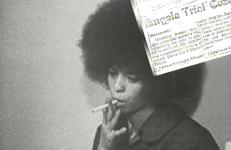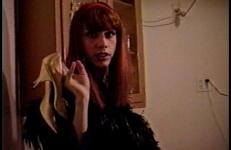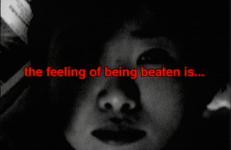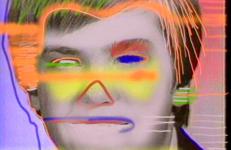1+8 is a film about Turkey’s unique position between West and East and her relationship to her eight very distinct and diverse neighbors. 1+8 is filmed close up on border towns of Turkey with Greece, Bulgaria, Georgia, Armenia, Nakhchivan/Azerbaijan, Iran, Iraq and Syria exploring what connects and separates the people on both sides. The film showcases through intimate portraits, personal accounts and cinematographic tropes, Turkey’s eight borderlands revealing the political and cultural dynamics of life on those frontiers.
Politics
This is an audiovisual manifesto in support of people in resistance against a military coup.
This archival film remixes the systemic violence and power throughout the 1984 National Day Parade, the 1989 Tiananmen Square Protests, and the 2014 Umbrella Movement.
Bracketed by the Fall of Berlin Wall and the Collapse of the World Trade Center, a decade that saw the ossification of the neoliberal project, the rise of third-wave feminism, the proliferation of digital media, and even, perhaps, the “end of history": postmodernism; the emergence of internet; the commercialization of gangsta rap, and independent film; AIDS activist; digital cinema; the Gulf War; rave and riot grrrl cultures; reality television; MTV. A new diagrammatic system.
A wide-screen video diptych of scenes shot during two different periods in Moscow––old footage from 1990 and newer from 2009. There's no linear narrative as the "story" is told principally in the juxtaposition of the two images of the city with this almost 20yr gap. It runs 31 minutes as a single screening, but it is meant to be seen as an installation since its visual theme, from an American perspective, is the recurring cycle of Russian upheaval. It is also principally a "fractal" piece, meaning that its story is replicated in every scene.
–– Ken Kobland
In 30 Seconds Hate, Fox News and Henry Kissinger want to kill you as a tribute to George Orwell’s 100th birthday. Suckers gives a half-minute history of Halliburton in Iraq.
19 out of the 41 shots fired in 10-seconds by four members of the NYPD Street Crimes Unit hit the defenseless body of one Amadou Diallo as he stood in the vestibule of the building where he lived in the Bronx. This video essay seizes on the grotesquely bald, factual precision of this numerical data, proceeding remorselessly on up from number 1 to 41, rubber-banding 10-seconds into fourteen minutes, and then snapping it tight, in an intense, formal contemplation of how police violence is produced and then addressed by other forces on the city streets.
19 out of the 41 shots fired in 10-seconds by four members of the NYPD Street Crimes Unit hit the defenseless body of one Amadou Diallo as he stood in the vestibule of the building where he lived in the Bronx. This video essay seizes on the grotesquely bald, factual precision of this numerical data, proceeding remorselessly on up from number 1 to 41, rubber-banding 10-seconds into fourteen minutes, and then snapping it tight, in an intense, formal contemplation of how police violence is produced and then addressed by other forces on the city streets.
a/k/a Mrs. George Gilbert extends Coco Fusco’s in-depth examination of racialized imagery. Fusco combines fictional and documentary source materials to reflect on the use of electronic surveillance against Black intellectuals and activists in the 1960s and 1970s as part of covert FBI operations. These actions bear a striking resemblance to contemporary Patriot Act-inspired activities of American law enforcement.
Anthony Ramos' astute deconstruction of television news focuses on his part in the media coverage of President Jimmy Carter's 1977 declaration of amnesty for Vietnam draft evaders. Ramos, who had served an 18-month prison sentence for draft evasion, was interviewed by news reporter Gabe Pressman, whose film crew meets Ramos' video crew in a confrontation between technologies and sensibilities. At the time, some broadcast television news crews still used 16mm film, although the expensive transition to ENG (electronic news gathering) systems had begun in 1974.
Abscam (Framed) frames the FBI sting operation known as "Abscam" by mixing FBI surveillance footage of Congressman Michael "Ozzie" Meyers with footage shot by Lord at the Motel where the original sting occurred—in the process, inserting the artist into this moment in history.
Acid Migration of Culture occupied the main windows of the Donnell Library, the branch of the New York Public Library directly across from the Museum of Modern Art. The piece concerns the hot topic of censorship in the arts with statements from over fifty artists, critics, politicians, and religious leaders.
A welcome as warning. Frequent collaborators and proxies for New Red Order - Jim Fletcher and Kate Valk co-host a confrontation with the viewer about the passivity of ongoing settler-colonial occupations, and introduce a contrite, yet self-congratulatory stew of televised recordings of public apologies to Indigenous peoples from the heads of state around the globe. Featuring Donald Trump, Queen Elizabeth, Prime Minister of Australia Kevin Rudd, President of Taiwan Tsai Ing-wen, Prime Minister of Canada Justin Trudeau and more!
A call for a political transformation, a life that emerges from the earth's own interior.
A Kafkian vision of the New World. The arrival of Karl Rossman to the contemporary Babylon under the spell of the paranoid avant-garde. Kinetic coexistence of the archaic forms in dissolution.
In the video An Evening with Kembra, Glennda and Brenda attend one of Kembra Pfahler's dinner shows on New York City's Lower East Side. At her show, she performs cabaret versions of songs from her band The Volumptuous Horror of Karen Black. After the show, the group discusses the relationship of her work to queer culture. Interspersed throughout the video are two short clips: a skit entitled Drag Queen Starter Kit, and a call to boycott a bakery due to its discriminatory behavior.
A political composition on natural resistance. These images are an expiring breath in danger of extinction. These images become extinguished, consumed: a drop, a pure intensity which only appears when falling. In the presence of the image these audiovisual crowds become an affected body, assaulted by entropy. A face exhausted and reanimated by the continuous sound trance that traverses the battlefield. Faces for an eye that would not need to see.
In conversation with curator and educator Mary Jane Jacob, visual artist Ann Hamilton (b. 1956) talks about care, interactivity, and social relations — key concepts that preoccupy her practice — and why she feels compelled to revisit these issues under the Trump administration. Hamilton was trained in textile design and sculpture, and she received her MFA from Yale University School of Art in 1985.
Anna Pina Teresa reinterprets the pivotal scene in Rossellini’s Roma Città Aperta where Anna Magnani, who plays the character Pina, (based on the story of Teresa Gullace,) is murdered on the streets of Rome by the Fascist police. This scene is characterized by three movements performed by Magnani — resistance, running and falling. Filmed in the Sala Scherma at Foro Italico in Rome (Mussolini’s fencing studio designed by Moretti) Anna Pina Teresa examines the contemporary and historical dynamics between an urban Fascist space and movements of resistance.
Another Clapping explores the relationship triangle between a daughter, her mother and the Chinese Cultural Revolution. It is an experimental documentary based on the mother's violent past with its traumatic political history and an unsuccessful marriage. Through their subsequent experiences as immigrants in Canada and the complex process of remembering and reviewing the past, history comes to signify the characteristic of the individual. The tracing of memory illuminates the difficulties of identifying mother and daughter as different people.
Employing footage from an obscure 8mm film trailer for Battle for the Planet of the Apes to highlight the unstable relationship between the real, historical past and the distant, imaginary future, this project revolves around a central question: Is alien-ness indeed the metaphor for the 20th Century as power relationships have been embodied within our subconscious? Is there a relationship between these forgotten formats and the discontinued political ideologies that they depict?
A psychedelic portrait of the founding theorist of Christianity.
The story of Paul the Apostle’s life, ideology, and influence is told by piecing together 20th century 16mm and cassette propaganda, board games, animation, reenactments, Roman Empire doom metal and covers of Catholic liturgical music. The gentle Paul themes of flute, acoustic guitar, and mellotron contrast with the Demonic Roman Empire themes of electric guitar, drums and synth. Performance artist Linda Mary Montano and Usama Alshaibi portray Paul on his journey.
“The syntactic structure and lateral movement of Arcade match its fairground equivalent. The work includes a series of images recycled from television and film, interspersed with location footage of Chicago El stations and punctuated with paintings created by Paschke on a computerized paint box. Flashing insights and lights, the ready-made imagery presents a sideshow of current concerns playing on the slippage between the televised and the real.”
“The syntactic structure and lateral movement of Arcade match its fairground equivalent. The work includes a series of images recycled from television and film, interspersed with location footage of Chicago El stations and punctuated with paintings created by Paschke on a computerized paint box. Flashing insights and lights, the ready-made imagery presents a sideshow of current concerns playing on the slippage between the televised and the real.”
















![AlienNATION [star spangled], New Red Order AlienNATION [star spangled], New Red Order](/sites/default/files/styles/215x140/public/2025-02/ALIENNATIOSS.jpg?itok=fa7jU7tV)









